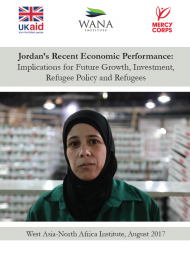-
Jordan’s Recent Economic Performance: Implications for ...
Jordan’s Recent Economic Performance: Implications for Future Growth, Investment, Refugee Policy and Refugees
The past six years have been transformative for the Hashemite Kingdom of Jordan. As a result of the civil war in Syria, the country has absorbed more than 660,000 Syrian refugees according to the United Nations Refugee Agency; while the official census, which was conducted in December 2015, estimates the number of Syrians present in the country much higher, totalling 1.265 million, or approximately 13 per cent of the country’s total population. In February 2016, the landmark Jordan Compact was signed between Jordan and a range of donor countries and international organisations. The agreement — one of the first of its kind — took a new and innovative approach to humanitarian response, bringing a diverse set of actors into a multiyear agreement aimed at providing tangible economic outcomes for both Syrian refugees and the Jordanian host community.
This series of pivotal events must be understood against two, largely unrelated, narratives that are at the core of the country’s modern economic history. The first is Jordan’s longstanding goal of positioning itself as a high-value added, knowledge-based economy within the West Asia - North Africa region. The second is the apparent divergence between investment and employment growth that has been recently noted in five industrial sectors, according to Jordan Chamber of Industry data. The positioning of the two narratives vis-à-vis the Syrian refugee crisis presents a new set of questions for Jordan, as well as the international financial institutions whose job it is to advise Jordan on its medium-to-long term economic growth strategy. This report provides a first step towards untangling these questions and sets an agenda for additional research that we hope will inform the future designation of priority sectors and investments.

